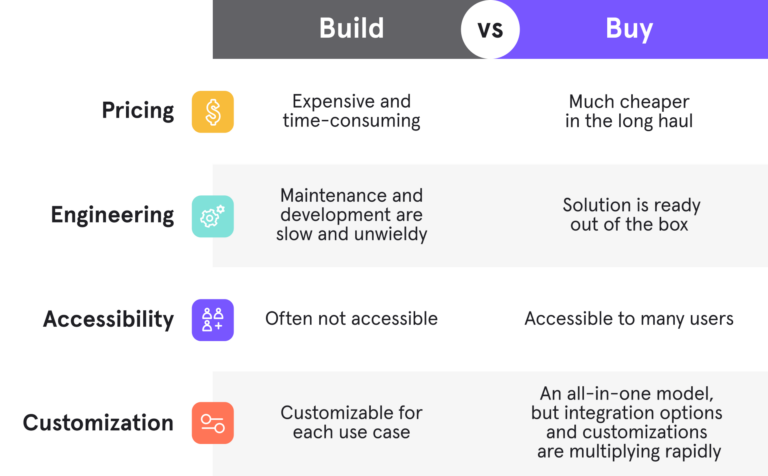Building product analytics vs. buying product analytics
Companies need insights on how their customers use their digital products, but they face a dilemma between building a solution in-house and buying an external tool.
Some companies have landed on the “build” side of the debate when it comes to product analytics as they’ve wanted tools that connect with existing systems and have precise customization. However, modern product analytics software has advanced to a point where “buying” can meet (or often exceed) business needs.
Either choice comes with costs and benefits that need to be considered before making a final decision.
Making good use of engineering resources
Building product analytics in-house can take away valuable engineering resources and time. Instead of working on developing a better product, companies get stuck building better internal tools. Internal tools can serve as an effective temporary fix–for example, a company needs to track user interactions, so they create a quick SQL query, add a new table, and collect data. But as a company adds millions of users, a simple internal tool can become a massive time sink. Even with top-notch business intelligence tools, companies will still need to invest significant resources to create reports.
“If we’d had to build an internal solution, we would’ve had to slot it into our roadmap,” Ryan Stinson, a Mixpanel customer, said in a recent interview. “It would’ve been continuously deprioritized against new product features and would’ve been at a high risk of never reaching its full potential or providing the tools we needed for the business.”
An external product analytics tool removes many of these barriers. Engineers no longer need to spend time building an internal tool, as external software can take hours to implement, not months. That saves on resources, time, and costs that can be used elsewhere.
The hidden costs of in-house solutions
Companies may think that the only costs of developing an internal product analytics tool stem from initial engineering. In reality, companies typically need to spend significant resources on training, support, and maintenance.
For example, when employees need to be trained on an internal tool, that effort might come from the company’s technical team that built it. Same for the creation of internal help pages and any other continued support. When you buy a software solution from a company like Mixpanel, demos, support, and other resources are offered from our end.
When it comes to updates to internal tools, internal development time and additional effort for system monitoring come into play. As companies expand, the costs to maintain the internal tool will also grow as new features and technologies are added.
“When we were only using our own tech, we would’ve had to manually review this daily or set aside engineering time to develop a solution,” Ryan Stinson said. “But with Mixpanel we’ve been able to do this without having to code anything.”
In the long run, purchasing a software tool can prove cheaper. Because companies like Mixpanel work on product analytics full-time, we can focus effort on making data queries cheaper and faster. Mixpanel studies have found companies can save $30,000 month in storage costs by providing these services in an all-in-one tool.
Control and connectivity
Companies often hesitate to buy an external product analytics tool because they need highly customized solutions. This is understandable–no business wants to purchase a tool that can’t track the events and produce the analysis it needs.
However, modern product analytics software can ingest large amounts of data while providing instant alerts and insights for many key areas like customer retention, user workflows, and funnels. While a universal tool can’t handle every unique edge case, engineers can spend their time focusing on accommodating these isolated issues instead of building the entire tool from scratch.
External tools are also becoming more compatible with other third-party software tools. Mixpanel has a long list of third-party data tools that can be integrated with its product analytics tool. Customers can also perform custom queries on exported warehouse data. We help people receive highly customized analytics without dealing with engineering debt.
Accessibility and visibility matters
Most any in-house solution has to be paired with a data visualization tool. A series of bloated and siloed Excel tables won’t do much good for anyone when it’s time to make a company-defining product roadmap. Product analytics must be visible to many stakeholders at once. If an internal tool leads to key analytics being trapped on a “data gatekeeper’s” Google Drive folder, it’s not worth building.
“We’re using cohorts to better understand the behavior of different customer groups at once, information that gives us clues about what we need to address in the product for which users,” Ryan Stinson said. “And no matter how many different ways we cut our user behavior into groups, it can all still be viewed in cumulative totals in a variety of ways, including the typical (but very important) across-the-board numbers like monthly active users, daily active users, popular actions, etc.”
With pretty much all product analytics tools on the market today, data visualization features are included and made readily available. In Mixpanel, dashboards and reports can also be quickly and easily accessed by multiple team members. This saves stakeholders time and energy when making critical business decisions.

The verdict
Of course, all the above considerations will weigh differently for almost every individual company on the planet. So how should decision-makers apply them to their specific build vs. buy product analytics conundrum?
A good starting point for organizations of all sizes, from small startups to multinational enterprises, is to understand that their focus should be on creating better products that meet customers’ needs. Many companies will find they can easily bring in a modern product analytics solution like Mixpanel and keep their time, money, and effort directed on what’s most important.


